|
|

Use the CiscoWorks Blue Administration application to add, delete, modify, and discover devices in your CiscoWorks Blue database, and to select DLSw key devices. (DLSw key devices are described in the "Using Key Devices" section.
The following topics describe how to use the administration application:
This topic describes how to start the CiscoWorks Blue Administration application. You can start the application either from the workstation system prompt or from a network management system, such as NetView for AIX, as described in the following topics:
The CiscoWorks Blue Administration application is accessible from /opt/CSCOcb/bin/. To start the application from a system prompt, enter the following commands:
cd /opt/CSCOcb/bin
./cwb start admin
You can log in to a remote UNIX host from your own local UNIX workstation, export the remote host display to your local workstation, and then run the application from the remote host. To start the remote host's CiscoWorks Blue Administration application from your local workstation, use the following procedure:
Step 1 At your local UNIX workstation, enter the following command:
xhost +
Step 2 Log in to the remote UNIX host as root (or with a username of your own choosing).
Step 3 Set your DISPLAY environment variable to export the display from the remote host to your local workstation. Depending on which shell you are using, use one of the following commands:
setenv DISPLAY
export DISPLAY=IP_address:0.0
setenv DISPLAY IP_address:0.0
Step 4 To start the CiscoWorks Blue Administration application, enter the following commands:
cd /opt/CSCOcb/bin
./cwb start admin
When you start the CiscoWorks Blue Administration application, the CiscoWorks Blue Administration window (Figure 7-1) is displayed. See the topic "Administration Window" for information about the CiscoWorks Blue Administration window.

Use the main window to perform the following tasks:
Use the CiscoWorks Blue Administration window to add, delete, modify, and discover devices in your CiscoWorks Blue database, and to select DLSw key devices.
The Administration window has the following fields:
| Field | Description |
|---|---|
Edit Devices | Manipulates the devices in the database:
|
Discover | Discovers DLSw, RSRB, APPN, or TN3270 devices using either a seed file or a network management system database, and adds the discovered devices to the CiscoWorks Blue database.
|
Launch | Starts CiscoWorks Blue client applications:
|
The Administration window has the following buttons.
| Button | Description |
|---|---|
Exit | Exits the CiscoWorks Blue Administration application. |
Help | Displays online help in a web browser window. |
Use the CiscoWorks Blue Administration application to discover devices for the database. Use the following procedure to discover devices in the database:
Step 1 In the Discover field of the CiscoWorks Blue Administration window, select one or more of the following protocol types:
Step 2 Then select a method of discovery:
The appropriate discover processes are started to discover enabled devices and add them to the CiscoWorks Blue database. You will see a "Work in Progress" dialog while discovery is in progress.
You can add one or more devices to the database manually.
If a Cisco device does not appear on a map or web page, but you know that the device exists in the network, you can add the device using the Add button.
When you add a device, the application prompts you for the device's host name or IP address and read community string. The application then places the new device in the database. Use the following procedure to add a device:
Step 1 From the CiscoWorks Blue Administration window select Add. The Add Devices window (Figure 7-2) is displayed.
See the topic "Add Device Window" for information about the Add Device window.
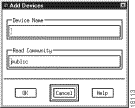
Step 2 In the Device name field, enter the host names or IP addresses, separated by spaces, of the devices that you want to add.
Step 3 In the Read Community field enter the read community string of the device that you want to add.
Step 4 Click OK.
The new device is added to the database. After you add new devices, the DLSw poller and cwbsnamapsd are automatically restarted to update the database with circuit information used in SNA correlation and to update the cwbsnamapsd cache with current TN3270 and APPN information.
Use the Add Device window to add a new device to the CiscoWorks Blue database.
The Add Device window has the following fields:
| Field | Description |
|---|---|
Device Name | Name of the device to add. |
Read Community | Read community string of the device to add. |
The Add Device window has the following buttons:
| Button | Description |
|---|---|
OK | Adds the specified device. |
Cancel | Cancels the operation and returns to the previous window. |
Help | Displays online help for the Add Device window. |
Use the Delete button to remove devices from the database. You might not want the devices for the following reasons:
Use the following procedure to delete unwanted devices from the database:
Step 1 From the CiscoWorks Blue Administration window, select Delete. The Delete Devices window (Figure 7-3) is displayed. The Devices field of the Delete Devices window lists all the devices (routers) in the database.
See the topic "Delete Device Window" for information about the Delete Device window.
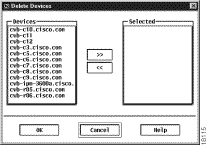
Step 2 In the Devices field, select all the devices that you want to delete.
Step 3 Click the >> button to move the selected devices into the Selected field.
Step 4 If you inadvertently move devices to the Selected field but do not want to delete them, select all the devices that you do not want to delete and click the << button to move them back to the Devices field.
Step 5 Click OK.
The selected devices are deleted from the database.
Use the Delete Device window to delete a device from the CiscoWorks Blue database.
The Delete Device window has the following fields:
| Field | Description |
|---|---|
Devices | Displays the devices currently in the database. |
Selected | Displays the devices to be deleted. Use the >> and << buttons to move devices between the Devices field and the Selected field. |
The Delete Device window has the following buttons:
| Button | Description |
|---|---|
<< and >> | Moves devices between the Devices field and the Selected field. |
OK | Deletes the specified devices. |
Cancel | Cancels the operation and returns to the previous window. |
Help | Displays online help for the Delete Device window. |
Change the read community string for one or more devices using the following procedure:
Step 1 From the CiscoWorks Blue Administration window, select Modify. The Modify Devices window (Figure 7-4) is displayed.
See the topic "Modify Devices Window" for information about the Modify Devices window.
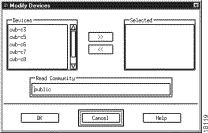
Step 2 In the Devices field, select all the devices that you want to modify.
Step 3 Click the >> button to move the selected devices into the Selected field.
Step 4 If you inadvertently move devices to the Selected field but do not want to modify them, select all the devices that you do not want to modify and click the << button to move them back to the Devices field.
Step 5 In the Read Community field, enter a new read community string to be applied to all the selected devices.
Step 6 Click OK.
The read community string is changed in the CiscoWorks Blue database (not in the router itself) for the selected devices.
The Modify Devices window has the following fields:
| Field | Description |
|---|---|
Devices | Displays the devices currently in the database. |
Selected | Displays the devices to be modified. Use the >> and << buttons to move devices between the Devices field and the Selected field. |
Read Community | Specifies the new read community string for the selected devices. |
The Modify Device window has the following buttons:
| Button | Description |
|---|---|
<< and >> | Moves devices between the Devices field and the Selected field. |
OK | Changes read community string for the specified devices. |
Cancel | Cancels the operation and returns to the previous window. |
Help | Displays online help for the Modify Device window. |
You may want the discovery process to rediscover a device if that device is now running different protocols or when you just want to update the database information about that device but you do not want to wait until the next polling interval. Use the following procedure to rediscover a device:
Step 1 From the CiscoWorks Blue Administration window, select Rediscover. The Rediscover Devices window (Figure 7-5) is displayed.
Step 2 In the Devices field, select all the devices that you want to rediscover.
If you select more than one device to rediscover, by pressing the Ctrl or Shift key while you select devices, they must all have the same read community string.
Step 3 Click the >> button to move the selected devices into the Selected field.
Step 4 If you inadvertently move devices to the Selected field but do not want to rediscover them, select all the devices that you do not want to rediscover and click the << button to move them back to the Devices field.
Step 5 Click OK.
The devices are rediscovered. After you rediscover devices, the DLSw poller and cwbsnamapsd are automatically restarted to update the database with circuit information used in SNA correlation and to update the cwbsnamapsd cache with current TN3270 and APPN information.
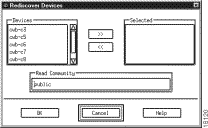
Use the Rediscover Devices window to rediscover a device in the CiscoWorks Blue database.
The Rediscover Devices window has the following fields:
| Field | Description |
|---|---|
Devices | Displays the devices currently in the database. |
Selected | Displays the devices to be rediscovered. |
Read Community | Specifies the read community string for the selected devices. |
The Rediscover Devices window has the following buttons:
| Button | Description |
|---|---|
<< and >> | Moves devices between the Devices field and the Selected field. |
OK | Rediscovers the specified devices. |
Cancel | Cancels the operation and returns to the previous window. |
Help | Displays online help for the Rediscover Device window. |
You can specify one or more devices as DLSw key devices using the following procedure:
Step 1 From the CiscoWorks Blue Administration window, select DLSw Key. The DLSw Key Device Selection (Figure 7-6) window is displayed.
See the topic "Key Device Selection Device Window" for information about the Key Device Selection window.
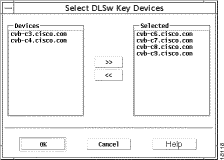
Step 2 In the Devices field, select all the devices that you want to make key devices.
Step 3 Click the >> button to move the selected devices into the Selected field.
Step 4 If you inadvertently move devices to the Selected field but do not want to designate them as key devices, select all the devices that you do not want to designate and click the << button to move them back to the Devices field.
Step 5 Click OK.
The devices in the Selected field become DLSw key devices. After you add key devices, the DLSw poller is automatically restarted to update the database with circuit information used in SNA correlation.
The Key Device Selection window has the following fields:
| Field | Description |
|---|---|
Devices | Displays the DLSw devices that are not key devices. |
Selected | Displays the DLSw devices that are designated as key devices. When you click OK, the devices in the Selected field become key devices while the devices in the Devices field are not key devices. |
The Key Device Selection window has the following buttons:
| Button | Description |
|---|---|
<< and >> | Moves devices between the Devices field and the Selected field. |
OK | Designates the devices in the Selected field as DLSw key devices. Designates the devices in the Devices field as not key devices. |
Cancel | Cancels the operation and returns to the previous window. |
Help | Displays online help for the Key Device Selection window. |
You can launch the Process Manager client from the Administration window. From the CiscoWorks Blue Administration window, click Process Manager. The Process Manager client application starts and the Process Manager window is displayed.
See the "Using Process Manager" for information about using Process Manager.
You can launch the Message Log client from the Administration window. From the CiscoWorks Blue Administration window, click Message Log. The Message Log client window is displayed.
See the "Using the Message Logger" for information about using the Message Log viewer.
You can launch the Installation Verification web page from the Administration window. From the CiscoWorks Blue Administration window, click Verification. The web browser is started, which displays the Verification web page. The Verification web page verifies the protocols that you configured during installation, checks the cwbinit configuration file, and checks the CiscoWorks Blue database.
![]()
![]()
![]()
![]()
![]()
![]()
![]()
![]()
Posted: Wed Jun 30 06:33:49 PDT 1999
Copyright 1989-1999©Cisco Systems Inc.